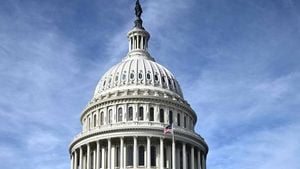President Donald Trump’s ambitious White House renovation—centered on demolishing the historic East Wing to make way for a massive new ballroom—has ignited a firestorm of controversy, raising concerns about health hazards, historic preservation, political influence, and the project’s funding. As excavators finished tearing down the East Wing on October 23, 2025, critics and supporters alike found themselves embroiled in a debate that reaches far beyond the White House’s iconic grounds.
According to a Washington Post-ABC News-Ipsos poll conducted between October 24 and 28, a decisive 56 percent of Americans said they “somewhat” or “strongly” oppose President Trump’s $300 million ballroom project. Only 28 percent voiced support. The poll, which included 2,725 respondents and a margin of error of 1.9 percentage points, underscores the public’s deep ambivalence about the largest White House construction effort since President Harry Truman’s era.
The ballroom—designed to seat 650 and accommodate up to 1,000 guests—will span an astonishing 90,000 square feet. President Trump, who announced the project on July 31, 2025, has pitched it as a long-overdue upgrade to the White House’s capacity to host dignitaries and major events. “Over the years many presidents have made changes. This obviously would be the biggest change. But this is something they’ve wanted for at least 150 years,” Trump said last week, as reported by ABC News and The Washington Post.
Yet the project’s scale and speed have fueled not just public skepticism but also alarm among lawmakers and advocacy groups. The Asbestos Disease Awareness Organization (ADAO) sounded the alarm in a press release, warning, “Federal law requires comprehensive asbestos inspection, notification, and abatement before any demolition. No publicly available information demonstrates that these statutory obligations have been fulfilled.” The White House, for its part, has insisted that a “very extensive abatement and remediation assessment was followed, complying with all applicable federal standards,” and that “any hazardous material abatement was done in September.” However, officials have neither confirmed nor denied the presence of asbestos, a material commonly used in buildings from the 1940s and 1950s, when the White House last underwent major reconstruction.
Linda Reinstein, president of the ADAO, expressed lingering doubts: “I am deeply concerned for White House staff and others working in or near the East Wing demolition site. It remains unclear what measures have been taken to ensure the safe removal of deadly asbestos and other hazardous materials.” The potential health risks extend to construction workers, nearby office staff, tourists, and passersby, with Massachusetts Senator Ed Markey stating in a letter to ACECO of Maryland, the demolition firm, “The demolition of a structure of the age and historic national significance of the East Wing demands the highest possible standards of care, not the lowest bid and a blind eye toward regulation. Construction workers on the East Wing site, nearby office workers and tourists, and passersby could now be at heightened risk of developing lung cancer, asbestosis, or mesothelioma from the inhalation of demolition dust.”
Beyond health and safety, the project’s funding has emerged as a major flashpoint. President Trump has repeatedly asserted that the $300 million price tag—up from the initial $200 million estimate—will be covered entirely by private donations, including contributions from major corporations like Amazon, Apple, and Google, as well as from Trump himself. “This project will come at no expense to the taxpayers thanks to the generosity of patriotic donors, including the President himself,” Trump claimed on Truth Social. However, Senate Democrats, led by Senator Adam Schiff of California, have demanded a full accounting of all donations, warning in a letter to White House chief of staff Susie Wiles, “We write to express serious concerns regarding President Trump’s financing of the new White House ballroom construction project through private donations from individuals and corporations whose business interests are deeply impacted by the administration and its decisions.”
Adding to the funding controversy, President Trump is currently suing the federal government for $230 million in damages related to the FBI’s 2016 search of his Mar-a-Lago property. If successful, the payout would come from taxpayer funds, potentially undermining Trump’s claims that the ballroom project is entirely privately financed. As PBS reported, this legal maneuver has not gone unnoticed by critics wary of blurred lines between public and private resources.
The project’s rapid approval has also raised eyebrows. Demolition began on October 20, 2025, despite lacking approval from the National Capital Planning Commission (NCPC), the executive branch agency responsible for overseeing government building renovations. In a move reminiscent of power plays from the 1940s, President Trump sacked all six Biden-appointed members of the Commission of Fine Arts, clearing a path for his renovation plans—including the so-called ‘Arc de Trump.’ According to contemporary reports, such tactics harken back to a time when presidents wielded sweeping authority to reshape the nation’s most symbolic residence.
For preservationists and historians, the loss extends beyond bricks and mortar. The East Wing, which previously housed the offices of First Lady Melania Trump, the White House social secretary, the calligrapher, the movie theater, and the presidential bunker, is now gone. The project will also erase the Jacqueline Kennedy Garden and remove at least six historic trees, including southern magnolias planted in 1947 and dedicated to Presidents Warren G. Harding and Franklin D. Roosevelt, as reported by Elle Decor. For many, these losses are irreplaceable.
This is not the first time the Trumps have left their mark on the White House landscape. In 2020, First Lady Melania Trump added a 1,200 square foot tennis pavilion on the South Lawn. In 2025, President Trump funded the installation of two 88-foot flagpoles, a $2 million limestone tile replacement in the Rose Gardens, and Oval Office renovations featuring gold accents and new portraits, according to The White House.
The president’s appetite for grand-scale renovation doesn’t stop at the White House. On October 27, 2025, Trump announced sweeping plans to overhaul the Kennedy Center, where he was elected Board Chair earlier this year. He replaced David M. Rubenstein and appointed Richard Grenell as interim President, vowing to make the “TRUMP KENNEDY” Center “the finest Arts and Entertainment Center anywhere in the World.” Renovations will include new ceilings, chandeliers, wall coverings, stages, seating, carpeting, and HVAC systems. As Trump put it on Truth Social, “I am doing the same thing to the United States of America, but only on a ‘slightly’ larger scale!”
The ballroom project has also attracted scrutiny from other corners of Congress. A Connecticut senator has pressed contractors for details on how they became involved with the construction, reflecting the broader atmosphere of skepticism and oversight that now surrounds the White House’s most significant transformation in decades.
With the dust still settling—literally and figuratively—over Pennsylvania Avenue, the future of the White House’s East Wing and its new ballroom remains a flashpoint in American politics. For now, the debate over history, health, money, and power continues to swirl as the capital braces for the next phase of this unprecedented renovation.





